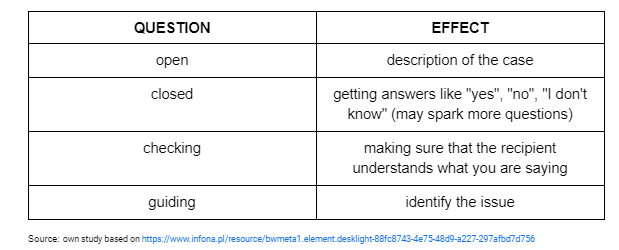Starting with the definition, the PWN dictionary defines communication as: “transmitting and receiving information in direct contact with another person,” but also “the flow of information between devices, for example, telephones or computers” or even “the ability to get from one room or place to another.”1 All these definitions can be summarized as “communication, conversation, exchange.” ‘The full process of communication takes place in two directions: sending and receiving2 and it plays an important role in the efficiency of the project. The transfer of information and knowledge is necessary for the operation of teams.
We should ensure smooth communication and at the same time collect feedback. This contributes to better coordination of tasks in the project team. Communication channels should be continuously open and as short as possible 3 .
Above all, you must communicate consciously: what you say and how you say it impacts the perception of your message. Through communication, you can effectively motivate people and engage them, but also demotivate them (even unintentionally). The human factor in communication is caused by our cognitive limitations, therefore, everything we want to express should be clear and transparent. We should always have a strategy, plan, and the right tools.
Be prepared
- Create clear messages. It’s worth thinking through what you want to say. Get ready for a meeting and reflect on the content of an email – even a few minutes of preparation give much better results. Keep in mind that emotions are a bad advisor, focus only on facts.
- Make sure you have appropriate conditions for the conversation and suitable communication channels. Not every time and place is good for a conversation. Ensure the comfort of both the sender and the recipient of the message 4.
- Adapt the information to the recipients and their personality types (adjust the tone and style of communication to your audience).
- Allow enough time for communication. Don’t let haste or pressure take over.
- Encourage feedback and respond to it.
Communicate through examples (sometimes an example is better than an argument). Follow the rule Less is more:
Make your statements understandable to everyone. Stick to simple messages. When explaining something complicated, use simple language (as if you were explaining it to a 10-year-old child). And remember: “If you can’t explain it simply, you don’t understand it well enough.” A. Einstein
Choose the right questions
Open, closed – what kind of questions should I ask? It depends on what you want to know. When you come across vague and unspecified issues, ask open questions. If you want to get a specific answer, closed questions are better. You can also use checking and guiding questions.
Listen actively
Listen carefully and ask for clarification if you don’t understand. Focus on the topic of the discussion and refer to what you have learned. Give feedback, and if you want to express criticism, make sure it’s constructive (without emotions and beliefs).
Get to know your interlocutors
It is worth getting to know your interlocutors, especially in the initial phase of communication. This makes it easier to adjust the message and send it through the right channel. Find out what level of understanding of different issues your audience has because it is one of the main causes of conflicts. When passing on information, you must be aware what impact it may have on the recipient and what reactions it can spark. It is also important not to judge your interlocutor and pay attention to emotions. And if you are talking about thoughts and feelings, refer only to your own. We can’t be sure what another person’s intentions are until they tell us about them.
When giving feedback and evaluation, focus only on specific behaviors, not on people in general. Statements like “you are so…” can stir up extreme emotions and cause additional conflicts. Try to calm down these emotions.
Reach out to people
Without seeing your reaction, the recipients of the message may feel lost. Then, it is harder to make your point of view convincing. Queen Elizabeth II used to say: “I have to be seen to be believed.” This quote can encourage you and the people you work with to use cameras when collaborating remotely. Recipients who get a message only via text or sound may trust the senders less and treat them less seriously. If we don’t provide any non-verbal clues, we severely limit our communication.
Make sure your interlocutors see you – use the camera during meetings and let people get to know you. Initiate such practices and set a good example. When I see my interlocutors, I automatically pay more attention to what they say. I also have a clearer picture of how my messages are understood. I interpret it through non-verbal communication.
Understand generational and cultural differences
I am a person from Generation Z and I find it interesting that people often make references and jokes about the previous system in small talk. For me, it’s sometimes incomprehensible but my interlocutors often bring up the topic of “how things used to be in communism, and how they are now.” People also have misunderstood me because of my use of English words in everyday speech. This caused consternation among recipients who usually speak either Polish or English (because how can you mix languages and why!?).
I also notice that younger people joining the labor market use completely new words. Recently, I had to google what “mieć esse” means (to be completely relaxed even in difficult situations). By the way, this phrase became the youth word in 2022. Languages are constantly evolving, but it’s important to remember that our audience may not understand every type of communication and it is better to stick to the simplest and most universal messages.
We could write a separate article on cultural differences or use some existing ones. It’s most important to understand, observe, and not judge. Let’s not put limits on communication ourselves.

Use punctuation
Punctuation is the key to written communication. In times when everything is hectic, we do not have time to wonder if our written messages are well-constructed. Have a look at the example below that illustrates the scale of the problem of not using punctuation.
X: Hi! Did the customer say if functionality A in the system is sufficient or do they want us to modify something?
Y: No more changes are necessary.
The Y message can be read in 2 different ways:
- No more changes are necessary.
- No, more changes are necessary.
Good punctuation makes it easier to understand the message. On the other hand, an excess or lack of punctuation may disturb communication 5. The argument that omitting punctuation marks and capital letters makes communication quicker is illogical. It often takes the recipient more time to “decipher” such a message than it would take the author to write it correctly 6. Remember that punctuation affects your messages and also the way you present yourself and your organization.
Give feedback
Feedback is an effective way of informing the sender that the recipient got the message. It also shows if the message was understood as intended and gives the opportunity to react accordingly. Those who do nothing make no mistake, so:
- If you notice that someone is making communication mistakes that significantly affect mutual understanding, signal it face to face and show support.
- During meetings, you can concisely paraphrase and summarize what the person said, making sure that your understanding of the issue is the same.
Thanks to this, you can avoid unnecessary conflicts and misunderstandings as well as increase trust between the sender and the recipient. And above all, set a good example yourself 🙂
Show empathy
First, try to understand, then seek to be understood. If someone doesn’t understand something, just explain it to them or point to a relevant source of knowledge. Don’t assume everyone knows everything. Share what you know and be open to other people and their needs.
Remember about inclusive language
Words have power and create our reality. That is why it is so important to use phrases and expressions that do not exclude anyone. Let’s pay attention to what we say and to whom we say it 7
Assuming something is obvious
You may think something is obvious and does not require explanation but your interlocutors may not see it that way. Make sure that everyone has the necessary level of understanding of all topics and issues.
Causing chaos
Consciously or unconsciously. The lack of order may result in chaos and lead to ineffective actions. Communication may fail if information is distorted, filtered, masked, or cut out.
Sooner or later will take its toll on the project.
What could be the reasons for such distortions of information?
- too vaguely conveyed and incomplete information that can be interpreted in different ways
- filtering out information according to subjective assessment
- information overload
- delivering information late or even after the deadline
- distortion of facts
Stream of thoughts
In short, you say out loud whatever comes to your mind.
Limit any “yyy” and “eee” sounds that don’t form words.
Making a team within a team
Information is available to a certain group of people. This is a big mistake. Don’t restrict people’s access to information. If you see that someone is uninformed, provide the necessary information and make sure that the message is clear.
Communication delay
Send and receive messages on time.

The first person that comes to your mind may be a Project Manager, Scrum Master, … or maybe Business Analyst (BA)?
A BA is often called a facilitator between business and IT. On the one hand, BAs collect requirements from the business, on the other hand, they translate them into tasks understandable for the project team. BAs don’t only support the achievement of business goals, but also communicate and explain them. They promote the project and its vision among stakeholders and project team members. From the project team’s point of view, the analyst’s involvement increases the quality of work. A BA explains assumptions clearly and concisely and provides answers to all questions related to the tasks. They also help to verify if the delivered solution meets the business requirements and project goals. Additionally, they can set an example of good communication practices for the team.
A BA is also the contact person between the team and the customer. They build relationships within the project team, between stakeholders, in the IT world, and between the customer and IT 8
I know from my and my colleagues’ experience that an analyst can be a cure for communication in the project’s Tower of Babel.
Engaging a specialist with such a wide spectrum of skills is worth considering. A BA may be the person who keeps the project running in terms of communication.
Everything and everyone influences communication in the team. Always pay attention to why and how you communicate. Well-functioning organizations, teams, and projects are based on effective communication – both external and internal. When working with people and for people, communication is an area that we can always improve. Therefore, it’s a good idea to hire people with high communication skills who significantly increase the quality of the project. This always translates into customer satisfaction and this is what we care about the most.
- https://sjp.pwn.pl/sjp/komunikacja;2472911.html
- R. A. Podgórski, Sociology of microstructure (academic textbook), Oficyna Wydawnicza Branta, Bydgoszcz – Olsztyn 2008, p. 86.
- https://www.infona.pl/resource/bwmeta1.element.desklight-88fc8743-4e75-48d9-a227-297afbd7d756
- https://witalni.pl/pojecie/zasady-skutecznej-komunikacji/
- http://refleksje.zcdn.edu.pl/wp-content/uploads/2017/01/2014_01_Wstyd_nie_rozumie%C4%87_interpunkcji.pdf
- http://forum.mlingua.pl/archive/index.php/t-35179.html
- https://socialp ress.pl/2022/05/czym-jest-jezyk-inkluzywny-i-jak-stosowac-go-w-komunikacji-marketingowej
- https://craftware.pl/staffing/analityk-biznesowy/
- Junior Business Systems Analyst•Business Analysis & Technical Writing
-
She has been involved in business/system analysis and data analytics projects for life sciences clients with over two years of commercial experience. Enthusiast of Agile development methodology. In her daily work, she effectively uses communication and team collaboration to achieve project goals.

